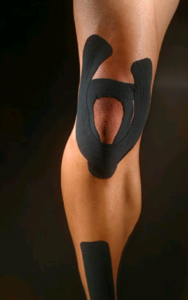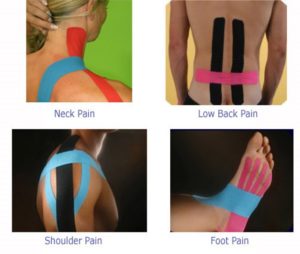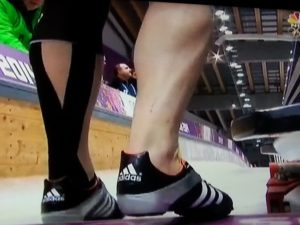Have you been to the gym working out on the elliptical, happened to look at the person next you, and noticed brightly colored tape wrapped around their shoulder? Or maybe you watched the Olympic bobsledding a few years back and noticed black tape on this athlete’s calf?
A few years ago, when I had achilles tendinopathy, I had blue tape on my achilles and calf to help alleviate the pain and many people asked me what that was and why I had it on. My husband calls this miracle tape “Windex”, like in the movie My Big Fat Greek wedding, where the dad believed Windex could fix anything that ails you.
That colored tape, which comes in a variety of colors, with no significant meaning, such as blue, black, beige, pink, spiderman, or bright green, is called kinesio tape or KT tape.
Although it seems to have become quite the colorful fad in recent years, this method of treatment has been around since 1979, when Japanese chiropractor, Dr. Kenzo Kase, developed Kinesio Taping to function similar to his hands on therapy to continue the healing process outside of the clinic.
So What is Kinesio Taping?
It’s a therapeutic taping method used to aid the body’s natural healing process while providing support and allowing full movement. From a physical therapy perspective, the KT tape promotes improvement of the neuromuscular system to improve function, returning homeostasis for the body, and helping to alleviate swelling (edema), pain, and bruising.
What is Kinesio Tape made of?

Kinesio Tape is a colored, elastic tape made of hypoallergenic cotton fibers and adhesive. These materials allow the tape to relax or stimulate muscles, unlike traditional tape which restricts blood flow and movement. It is latex free and can be worn up to three to five days through sweat, showers, or even swimming.
How does Kinesio Tape work?
Depending on the healing goal, the tape is applied in a certain direction, with a certain amount of stretch, and cut a certain way. These shapes include but aren’t limited to a straight line (I), an X, a Y, or a spider web like shape. When applied, the tape gently lifts the skin creating space between the layers of tissue lying beneath the skin allowing for improved lymph flow and circulation. By creating this space, inflammation and excess chemical build up is reduced and released.
What can Kinesio Tape be used for?
 KT tape can be used as an adjunct therapy to treat a multitude of issues such as: ankle sprains, bruising, muscle strain/tear anywhere in the body, rib fracture/pain, back pain, tendonitis, swelling, post-dental procedures, etc. Olympians, runners, people with disorders which affect their mobility, workers in a physically demanding job, and geriatric and pediatric patients can benefit from the effects of kinesio taping.
KT tape can be used as an adjunct therapy to treat a multitude of issues such as: ankle sprains, bruising, muscle strain/tear anywhere in the body, rib fracture/pain, back pain, tendonitis, swelling, post-dental procedures, etc. Olympians, runners, people with disorders which affect their mobility, workers in a physically demanding job, and geriatric and pediatric patients can benefit from the effects of kinesio taping.
I have found that when KT tape is added to a patient’s treatment plan, they walk out my door feeling much better than when they came in. If you feel you have an issue that could benefit from KT tape give me a call and we will give it a go!

Is There a Solution for Lower Back Pain?
Are you struggling with lower back pain or sciatica? Is it keeping you from doing the activities you enjoy? If so, download my free eBook: 9 Things You Can Do For Back Pain and Sciatica.








Great breakdown of kinesio taping! It’s amazing how this technique offers relief for a wide range of issues, from ankle sparin to back pain. This article nicely explains its versatility and potential benefits. Thanks for sharing!